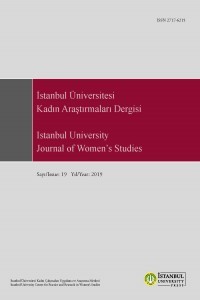BİR ÖZGÜRLÜK İHTİMALİ OLARAK ABJEKSİYON: SIRÇA FANUS VE KABUK ADAM’DA KİMLİK SORUNU
Bu çalışmada Aslı Erdoğan’ın Kabuk Adam ve Sylvia Plath’in Sırça Fanus romanlarında kimlik problemi irdelenmiş, kimlikleri yıkıma doğru evrilen ana karakterlerin abjeksiyonla ilişkisi, Julia Kristeva’nın abjeksiyon teorisi çerçevesinde tartışılmıştır. On dokuz yaşında New York’ta prestijli bir staj olanağı kazanan, aldığı eğitim ve idealleriyle toplumsal cinsiyet baskısı arasında bocalayarak geleceğini çizmeye çalışan Esther Greenwood ile kabul edildiği prestijli fizik okulları ve araştırma laboratuarlarında kendisini kıstırılmış hisseden Kabuk Adam’ın anlatıcısının öznelliklerini adım adım yıkışları takip edilmiştir. Çalışma boyunca Esther Greenwood’un yaşadığı kriz bir rol krizi olarak ele alınmış ve Kabuk Adam’ın anlatıcısının klostrofobi hissiyle karşılaştırmalı olarak tartışılarak, iki kahramanın farklı yöntemlerle abjeksiyona kaçışları izlenmiştir. İki metinde de görülen intihar, hastalık, suç ve gece gibi temalar öznenin özgürlük mücadelesi açısından çözümlenmiştir.Anahtar Kelimeler: Sylvia Plath, Aslı Erdoğan, Abjeksiyon, Toplumsal Cinsiyet, KimlikABJECTION AS AN ESCAPE POINT: THE PROBLEMATIZATION OF IDENTITY IN THE BELL JAR AND THE SHELL MANThis paper problematizes identity in Aslı Erdoğan’s The Shell Man and Sylvia Plath’s The Bell Jar in relation to Julia Kristeva’s theory of abjection. In The Bell Jar, the destruction of “I” is followed through the stories of Esther Greenwood, a nineteen year old girl who receives a prestigious prize in New York and is trapped between her ideals as a successful woman and the gender roles prescribed by society. Similarly, the narrator of The Shell Man is a twenty year old girl who feels alienated amidst prestigious physics schools and laboratories. Within the paper, Esther Greenwood’s “role crisis” and The Shell Man’s narrator’s claustrophobia are discussed from a comparative perspective, with abjection presented as a point of escape. The themes of suicide, illness, crime and night are analysed in relation to the struggle for freedom in both texts.Keywords: Sylvia Plath, Aslı Erdoğan, Abjection, Gender, Identity
Anahtar Kelimeler:
Sylvia Plath, Aslı Erdoğan, Abjeksiyon, Toplumsal Cinsiyet, Kimlik
-
This paper problematizes identity in Aslı Erdoğan’s The Shell Man and Sylvia Plath’s The Bell Jar in relation to Julia Kristeva’s theory of abjection. In The Bell Jar, the destruction of “I” is followed through the stories of Esther Greenwood, a nineteen year old girl who receives a prestigious prize in New York and is trapped between her ideals as a successful woman and the gender roles prescribed by society. Similarly, the narrator of The Shell Man is a twenty year old girl who feels alienated amidst prestigious physics schools and laboratories. Within the paper, Esther Greenwood’s “role crisis” and The Shell Man’s narrator’s claustrophobia are discussed from a comparative perspective, with abjection presented as a point of escape. The themes of suicide, illness, crime and night are analysed in relation to the struggle for freedom in both texts
Keywords:
Sylvia Plath, Aslı Erdoğan, Abjection, Gender, Identity,
___
- Axelrod, Steven Gould .“Alienation and Renewal in the Bell Jar”, Alienation, ed. Harold Bloom, New York, Infobase Publishing, 2009. s. 11-20.
- Bonds, Diane S. “The Separative Self In Sylvia Plath’s The Bell Jar.”Women’s Studies 18.1 1990,49.(Çevrimiçi) (2 Aug.2012).
- Buckley, Jerome Hamilton. “Season of Youth”, The Bildungsroman from Dic- kens to Golding, Cambridge, Harvard UP, 1974.
- Clute, John, John Grant, The Encyclopedia of Fantasy, Ed. Mike Ashley, Lon- don, Orbit, 1999.
- Cooper, Pamela. ““A Body Story with Vengance”: Anatomy and Struggle in The Bell Jar and The Handmaid’s Tale”, Women’s Studies, Vol. 26, Amsterdam, OPA, 1997.
- Erdoğan, Aslı. Kabuk Adam, 5. bs, İstanbul, Everest Yayınları, 2010.
- Erdoğan, Aslı. Kırmızı Pelerinli Kent, 7.bs, İstanbul, Everest Yayınları, 2009.
- Erdoğan, Aslı. Mucizevi Mandarin, 5. bs, İstanbul, Everest Yayınları, 2009.
- Erdoğan, Aslı. Taş Bina ve Diğerleri, 2. bs, İstanbul, Everest Yayınları, 2009.
- Foucault, Michel. Madness and Civilization: A History of Insanity In The Age of Reason, Abingdon, Routledge, 2005.
- Freud, Sigmund, The Uncanny, New York, Penguin, 2003.
- Friedan, Betty, The Feminine Mystique. New York, Dell.
- Gentry, Deborah S. The Art of Dying: Suicide in the Works of Kate Chopin, Edith Wharton and Sylvia Plath, New York, Peter Lang, 2006.
- Geuss, Raymond, Outside Ethics, England, Princeton University Press, 2005.
- Hoffman, Ernst T. A. “Sand-Man”, Weird Tales Vol., Gloucestershire, Echo Lib- rary, 2010, s.99-123.
- Kristeva, Julia. Korkunun Güçleri: İğrençlik Üzerine Deneme, Çev. Nilgün Tutal, İstanbul, Ayrıntı Yayınları, 2004.
- Kristeva, Julia. Powers of Horror: An Essay On Abjection, Çev. Leon S. Rou- diez, New York, Columbia University Press, 1982.
- Marmara, Nilgün. “Bir Dişi Lazarus”, Şiir Atı, İstanbul, 1987, s.168 – 172.
- Parla, Jale. “Tarihçem Kabusumdur Kadın Romancılarda Rüya, Kabus, Oda, Yazı”, Kadınlar Dile Düşünce: Edebiyat Ve Toplumsal Cinsiyet, Ed. Sibel Irzik, Jale Parla, 3. bs, İstanbul, Iletisim, 2009, s. 179 – 200.
- Peel, Robin. Writing Back: Sylvia Plath and Cold War Politics, Madison, Fa- irleigh Dickinson UP, 2002.
- Plath, Sylvia. “Lady Lazarus”, Çağdaş Dünya Şiiri Antolojisi, 2. Bs, İstanbul, Adam Yayınları, 2000, s.564.
- Sylvia Plath, Sırça Fanus, Çev. Handan Saraç, 9. b.s, İstanbul, Can Yayınları, 2011.
- Plath, Sylvia. “Stings”, The Collected Poems, ed. Ted Hughes, New York, Harper&Row Publishers, 1981,s.214 – 215.
- Tura, Saffet Murat. Freud’dan Lacan’a Psikanaliz, 4. bs, İstanbul, Kanat Kitap, 2010.
- Wagner, Linda W. “Plath’s Bell Jar as Female Bildungrsoman”, Women’s Studi- es: An Interdisciplinary Journal, Vol. 12, Nos. 1-6, 1986, s. 55-68
- Wagner-Martin, Linda. The Bell Jar, A Novel of the Fifties, New York, Twayne, 1992.
- Yayın Aralığı: Yılda 2 Sayı
- Başlangıç: 2019
- Yayıncı: İstanbul Üniversitesi
Sayıdaki Diğer Makaleler
ULUSLARARASI İŞGÜCÜ GÖÇÜ VE GERİDE KALAN KADINLAR: DENİZLİ ÖRNEĞİ
FEMINISM REDEFINING ECONOMICS OR FEMINISM AS A GOOD ACCOMPANY
GURBET NE YANA DÜŞER: SUYUN ÖTE YANINA
PATRİYARKA VE KAPİTALİZM İLİŞKİSİ: “KAZAN-KAZAN” SENARYOSU YENİDEN DÜŞÜNÜLÜRKEN
‘DİŞİL’ BİR İTAATSİZLİK: BİR ÖRNEKLEM OLARAK BEJAN MATUR ŞİİRİ
KÜRESELLEŞME, GÖÇ VE KADIN ÜZERİNE
BİR KADIN FELSEFECİNİN GÖZÜNDEN ARİSTOTELES VE FEMİNİZM
KADINLARIN SOSYAL VATANDAŞLIĞI VE BAKIM EMEĞİNE YÖNELİK TARTIŞMALAR
